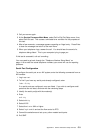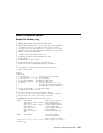
If your modem communicates properly with remote users, it is probably in control. It
may be wise to occasionally change some of the functional settings and then change
them back, just for the sense of security that the modem is communicating, and to
assure it has been initialized recently.
Another strategy, particularly if your system is difficult to access physically, is to
protect it with an Uninterruptable Power Source (UPS) and a phone-line surge
protector.
In case recovery becomes necessary, your system should be shut down as
gracefully as possible. Disconnect the power cable and press the power button to
drain capacitance while power is disconnected. Disconnect and reconnect modem
power, then reconnect system power to allow complete reinitialization of your system.
Seamless Transfer of a Modem Session
There are about as many modem command variations as there are modems. The
sample modem configuration files have been written to capture the largest number of
workable modem settings.
The modem command &Dn (where 'n' is a number) generally sets the modem
response to the Data Terminal Ready (DTR) signal from the server's serial port. The
desired response is that the modem will hold a connection while DTR is enabled,
and drop the connection when DTR is released. This is the mechanism by which the
server "hangs up" on a connection under normal conditions.
Usually the command &D2 will work, but not always. The sample modem
configuration files
2
take this high percentage position. You should consult your
modem's manual for its specific response scheme for the &Dn command.
There are two methods for dealing with the modem's response to DTR:
1. Recovery
2. Prevention
Before proceeding with one of these strategies, you need to determine if your
server's modem is set up properly to respond to DTR.
D-6
IBM RS/6000 7025 F50 Series User's Guide


















